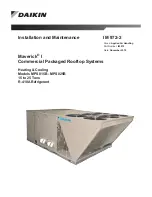
Mechanical Installation
www.DaikinApplied.com 11
IM 972-2 • MAVERICK I ROOFTOP SYSTEMS
LP Conversion
DANGER
This unit is equipped at the factory for use with natural gas only. Conversion
to LP gas requires a special kit supplied by the distributor or manufacturer.
Mailing addresses are listed on the furnace rating plate, parts list and
warranty. Failure to use the proper conversion kit can cause fire, carbon
monoxide poisoning, explosion, personal injury, property damage, or death.
Convert the unit to use liquefied petroleum (LP) gas by
replacing with the gas valve supplied in the conversion kit. The
LP gas valve maintains the proper manifold pressure for LP
gas. The correct burner LP orifices are included in the kit. See
Figure 8 for component locations.
IMPORTANT:
To remove the natural gas valve, remove the
four screws securing the manifold pipe to the burner tray.
Remove the manifold pipe with gas valve attached.
NOTE:
Order the correct LP conversion kit from the furnace
manufacturer. See Conversion Kit Index shipped with
unit for proper LP kit number. Furnace conversion to
LP gas must be performed by a qualified technician.
Adjusting or Checking Furnace Input
• Natural Gas Line Pressure: 5"–10.5" W.C.
• LP Gas Line Pressure: 11"–13" W.C.
• Natural Gas Manifold Pressure: 3.5" W.C
• LP Gas Manifold Pressure: -10" W.C.
Supply and manifold pressure taps are located on the gas
valve body 1/8" N.P.T. and on the manifold (see Figure 9).
Use a properly calibrated manometer gauge for accurate gas
pressure readings.
Only small variations in the gas flow should be made by means
of the pressure regulator adjustment. Furnaces functioning
on LP gas must be set by means of the tank or branch supply
regulators. The furnace manifold pressure should be set at 10”
W.C. at the gas control valve.
To adjust the pressure regulator, remove the regulator vent
cover and turn the adjustment screw clockwise to increase
pressure or counterclockwise to decrease pressure (
).
Then replace the regulator vent cover securely
.
Any necessary major changes in the gas flow rate should be
made by changing the size of the burner orifices. To change
orifice spuds, shut off the manual main gas valve and remove
the gas manifold.
For elevations up to 2,000 feet, rating plate input ratings apply.
For high altitudes (elevations over 2,000 ft.), contact Daikin
Parts.
Check of input is important to prevent over-firing of the furnace
beyond its design-rated input. NEVER SET INPUT ABOVE
THAT SHOWN ON THE RATING PLATE. Use the following
table or formula to determine input rate.
Cu. Ft./Hr. Required = Heating Value of Gas (BTU/CuFt) × 3600
Time in Seconds for 1 Cu. Ft. of Gas
Start the furnace and measure the time required to burn one
cubic foot of gas. Prior to checking the furnace input, make
certain that all other gas units are shut off, with the exception of
pilot burners. Time the meter with only the furnace in operation.
IMPORTANT NOTE FOR ALTITUDES ABOVE 2,000 FEET
(610 METERS):
The main burner orifices in your furnace and
in these kits are sized for the nameplate input and intended
for installations at elevations up to 2,000 feet in the USA or
Canada, or for elevations of 2,000 - 4,500 feet (610 - 1,373
meters) in Canada if the unit has been derated at the factory.
For elevations above 2,000 feet (610 meters)
IN THE USA
ONLY
(see ANSIZ223.1), the burner orifices must be sized to
reduce the input 4% for each 1,000 feet (305 meters) above
sea level.
NOTICE:
Derating of the heating input for high altitude in the
field is unlawful in Canada (refer to CAN/CGA 2.17). Units
installed in altitudes greater than 2,000 feet (610 meters)
must be shipped from the factory or from a factory authorized
conversion station with the heating input derated by 10% so
as to operate properly in altitudes from 2,000 - 4,500 feet (610
1,373 meters).
Содержание Maverick I
Страница 51: ......












































